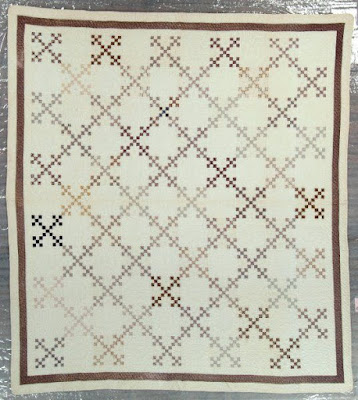Nine Patch quilts are as old as the hills, so to speak. But is it such a fun pattern and has so many settings and applications. It never gets old.
For the next two weeks, we'll be taking a tour of 19-century examples. This first batch has the color brown in common. They all are so warm and welcoming to me. Calming. More for my list!
"South
Carolina Nine-Patch"
Maker
Unknown
83"
x 83"
c.
1875
Lorie Stubbs Collection
Isn't this a fun one? I really like square in a square sets and this one is no exception!
You can see the original post about it here:
* * * * * * *
Double Nine Patch
Jean R. Frances Ridgly
1860-1900
Collection of the Grand Rapids Public Museum
Isn't this just an elegant one? I love the simplicity and the random placement of the earth-toned palette.
* * * * * * *
Pennsylvania
74" x 88"
1870
Isn't it an interesting border on this one? It appears that the brown and white are not pieced together, rather the white is appliquéd over the brown. There are lots of fun 1870's fabrics in the small 3 1/2" blocks.
As of today, it is for sale and you can see it and lots of close-up pictures here:
http://www.stellarubinantiques.com/items/472520/enlargement472520sra.html
* * * * * * *
Nine Patch Postage Stamp
Circa 1870
This one is gloriously busy. Lots of blocks! 480 nine patches with 361 alternating plain squares! Wow. I like the double checkerboard border, too.
That's it for today. Next week we'll take a look at some more interesting uses of nine patch blocks.
Thanks for joining us today!
Happy Quilting!
PLEASE NOTE:
- I am not a quilt historian. I simply enjoy finding interesting quilts and sharing them with you!
- The quilt images on this post were sourced from Pinterest, unless otherwise noted, and are linked to their origin whenever possible.






No comments:
Post a Comment